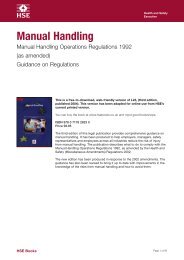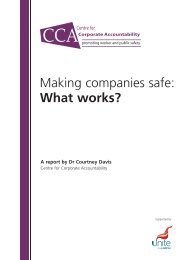Sustainable Transport and the Environment Guide - Unite the Union
Sustainable Transport and the Environment Guide - Unite the Union
Sustainable Transport and the Environment Guide - Unite the Union
You also want an ePaper? Increase the reach of your titles
YUMPU automatically turns print PDFs into web optimized ePapers that Google loves.
Percentage empty running<br />
Vehicle type<br />
Business Type Rigids Artics All vehicles<br />
Hire or Reward 29.8 25.6 27<br />
Own account 27.5 28.6 27.8<br />
Agriculture, forestry <strong>and</strong> fishing 40.7 34.8 38.2<br />
Energy <strong>and</strong> water supply 58.3 50.7 58<br />
Manufacture, mining <strong>and</strong> quarrying 25.7 312 27.7<br />
Construction 44.0 38.9 43.6<br />
Wholesale & retail trade, repairs <strong>and</strong> hotels 25.5 26.3 25.8<br />
<strong>Transport</strong>, storage <strong>and</strong> communication 27.8 15.7 23<br />
Banking, finance <strong>and</strong> insurance, business services <strong>and</strong> leasing 29.1 33.6 29.6<br />
Education, public admin & defence, extra-territorial<br />
organisations<br />
61.8 32.7 60.9<br />
Health, social work <strong>and</strong> o<strong>the</strong>r community services 17.1 46.3 79.8<br />
All business types 28.4 26.4 27.4<br />
Source: Table 1.6 Road Freight Statistics 2007<br />
Table 6.2: Percentage empty running lorries<br />
The ETF fully supports a policy aiming for modal shift <strong>and</strong> <strong>the</strong> internalisation of all<br />
external costs in all transport modes. This is essential for an environmentally<br />
sustainable transport system.<br />
This policy must be complemented by a policy that promotes intermodal transport <strong>and</strong><br />
concepts that combine <strong>the</strong> different transport modes in a sustainable way.<br />
However, “putting prices right” is not an aim, but a method to change transport <strong>and</strong><br />
production patterns. If internalisation of external costs is to be effective in terms of<br />
avoiding environmental damages, it is necessary that it is not transport workers, who<br />
pay <strong>the</strong> increase in price.<br />
It must be ensured through a number of social policy instruments <strong>and</strong> strict<br />
enforcement of social legislation, that higher infrastructure using costs are transferred<br />
to <strong>the</strong> customer <strong>and</strong> thus give <strong>the</strong> right (environmentally sustainable) price signals.<br />
Fur<strong>the</strong>rmore, a (environmentally) sustainable transport system needs a policy that<br />
aims at:<br />
Acknowledging <strong>and</strong> streng<strong>the</strong>ning <strong>the</strong> human element in environmental<br />
policies as well as respecting <strong>the</strong> close link between environmental <strong>and</strong><br />
working conditions, by tackling, amongst o<strong>the</strong>rs, fatigue <strong>and</strong> excessive<br />
workloads that raise <strong>the</strong> percentage of accidents having a negative impact on<br />
environment. If <strong>the</strong>re is an environmental impact assessment conducted at EU<br />
level, additionally <strong>the</strong>re should also be a social analysis with trade unions’<br />
involvement to ensure a win-win situation;<br />
Ensuring <strong>the</strong> effective implementation of existing environmental st<strong>and</strong>ards<br />
<strong>and</strong>/ or regulations. Never<strong>the</strong>less, <strong>the</strong>re is a clear need for improved, stricter<br />
<strong>and</strong> binding environmental regulations in <strong>the</strong> transport sector with a view to<br />
ensure higher respect for <strong>the</strong> environment;<br />
85
















